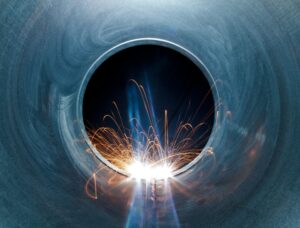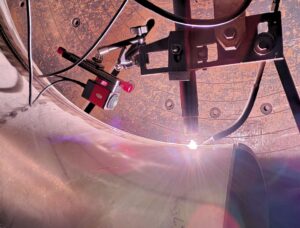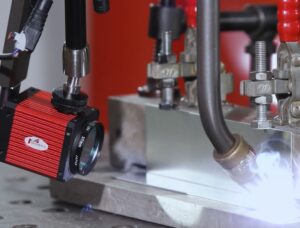Stick welding, also known as Shielded Metal Arc Welding (SMAW), is a widely used welding technique suitable for both beginners and professionals. This versatile and cost-effective welding process performs well in outdoor conditions and harsh environments. However, achieving high-quality results requires proper technique, weld monitoring systems, and welding cameras to prevent defects like slag inclusion and porosity. With the right welding equipment, safety precautions, and welding inspection techniques, SMAW can produce strong and durable welds. This guide will help beginners understand the fundamentals of stick welding, its advantages, and how to master the process effectively.
How Stick Welding (SMAW) Works
Stick welding uses an electric current to form an arc between a consumable electrode (welding rod) and the workpiece. The electrode is coated in flux, which melts during welding to protect the weld from atmospheric contamination.
Key Components of Stick Welding:
- Power Source: Provides the electrical current (AC or DC).
- Electrode Holder: Holds and controls the welding rod.
- Ground Clamp: Connects the workpiece to the welding circuit.
- Electrode (Welding Rod): Coated with flux to prevent oxidation and contamination.
Weld monitoring cameras can help capture arc welding images, allowing welders to assess arc stability and detect any weld problems in real-time.
Advantages of Stick Welding
1. Works in Harsh Environments
Unlike MIG and MAG welding processes, SMAW doesn’t require external shielding gas, making it ideal for outdoor and windy conditions.
2. Versatile for Various Metals
Stick welding is effective on a wide range of metals, including steel, cast iron, and stainless steel.
3. Cost-Effective Setup
SMAW requires minimal welding equipment, making it more affordable than TIG welding or MIG welding.
4. Portable and Easy to Use
Because stick welders are compact and lightweight, they are commonly used in construction, shipbuilding, and pipeline welding.
Common Stick Welding Issues and How to Avoid Them
Despite its advantages, SMAW can present challenges, particularly for beginners. Here’s how to prevent common weld defects:
1. Slag Inclusion
Problem: Slag can get trapped in the weld, weakening its structural integrity.
Solution:
- Hold the electrode at the correct angle (15-30 degrees).
- Use weld inspection techniques to check for slag buildup between passes.
- Remove slag between passes using a chipping hammer or wire brush.
2. Porosity in Welds
Problem: Air pockets or gas bubbles can form within the weld metal.
Solution:
- Keep electrodes dry and properly stored to prevent moisture contamination.
- Maintain a steady travel speed and avoid excessive weaving.
3. Inconsistent Arc Length
Problem: Holding the electrode too far from the workpiece can cause arc instability.
Solution:
- Maintain an arc length of 1/8 to 1/4 inch for consistent penetration.
- Use a weld monitoring system to observe arc performance in real time.
4. Undercutting
Problem: Excessive heat can cause grooves along the weld bead, weakening the joint.
Solution:
- Adjust the amperage settings to prevent overheating.
- Use a welding camera to monitor heat input and ensure even bead formation.
Welding Inspection and Quality Control for Stick Welding
Using welding inspection techniques can help identify weld problems early and ensure high-quality welds.
- Visual Inspection: Look for cracks, porosity, or incomplete fusion.
- Weld Monitoring System: Advanced weld cameras can detect arc stability and penetration depth.
- Non-Destructive Testing (NDT): Ultrasonic and X-ray tests can evaluate weld integrity.
Conclusion: Perfecting Your Welding Skills with Technology
Stick welding (SMAW) remains one of the most essential welding techniques, offering versatility, affordability, and strength. By avoiding weld defects and using modern weld monitoring technology, beginners can achieve consistent and high-quality welds.
Improve your stick welding results with Mecaweld’s welding cameras and inspection solutions.
Need better weld inspection solutions? Explore Mecaweld’s welding cameras to improve efficiency, accuracy, and defect detection in your welding processes.
Contact us today to learn how real-time weld monitoring can optimize shipbuilding and repair operations!



